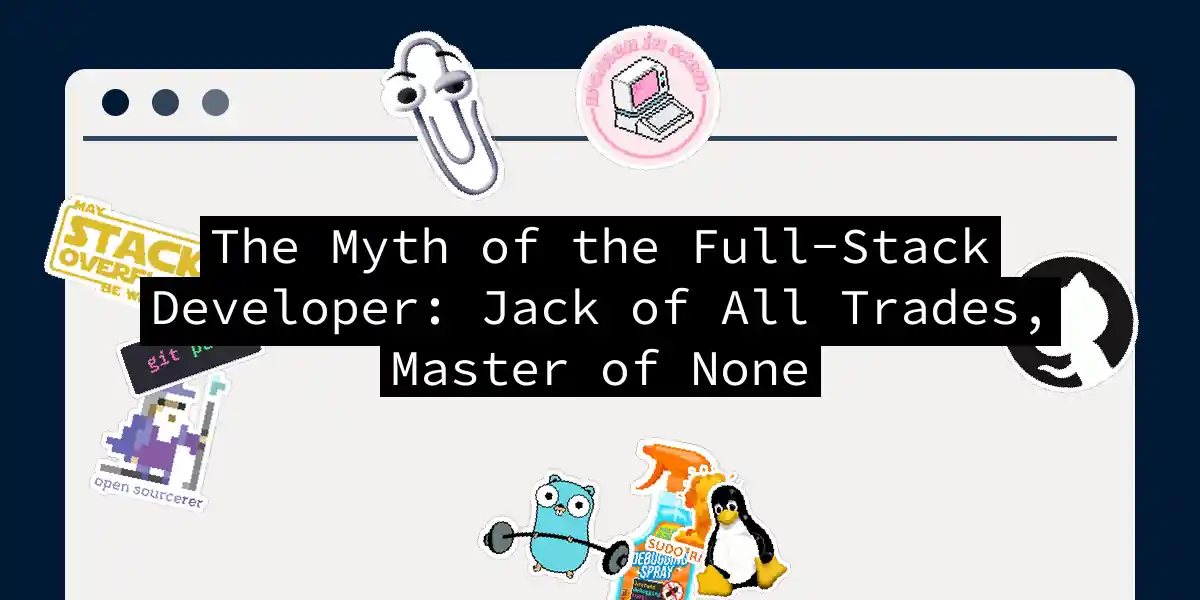Let me paint you a picture: a mythical creature roams the tech landscape, equally comfortable tweaking CSS animations and optimizing database indices. It deploys Kubernetes clusters before breakfast and argues about SVG accessibility over lunch. Meet the Unicorn Developer™ – a beautiful lie we’ve all agreed to perpetuate because it makes for great LinkedIn fodder.
The Origins of a Digital Tall Tale
The term “full-stack developer” emerged in the early 2000s when web development looked like this:
Fast forward to 2025, and the modern stack resembles:
Notice something? The “stack” has become a Jenga tower of technologies where pulling out one block makes the whole structure collapse. As Steve Mordue aptly notes, today’s business applications require teams rather than lone wolves.
The Reality of Wearing Multiple Hats
Let’s get practical. Can you actually build a full-stack application alone in 2025? Sure – if you enjoy the coding equivalent of spinning plates while juggling chainsaws. Here’s a survival guide: 1. The “Full-Stack Starter Pack” (Minimum Viable Madness):
npx create-next-app@latest --typescript
npm install @apollo/server graphql type-graphql typeorm pg
2. The Authentication Vortex:
// Because everyone loves implementing OAuth flow for the 147th time
import { auth } from "@auth/nextjs";
import { GitHubProvider } from "auth-providers";
import { encryptSession } from "@security/nuclear-codes";
3. Database Dependency Bingo:
-- Roll a D20 to see which ORM bug you'll encounter today
CREATE TABLE developer_sanity (
id SERIAL PRIMARY KEY,
remaining_patience DECIMAL(10,2)
);
The dirty secret? Most “full-stack” developers have spiky skill profiles – exceptional in one area, competent in others, and downright dangerous in a few. As Appinventiv notes, this doesn’t make them coding gods but rather technical polyglots.
When “Full-Stack” Becomes “Full-Stress”
Let’s play a game of technical debt roulette: Frontend Tasks | Backend Tasks |
Pixel-perfect responsive layouts | Database sharding strategies WebGL optimization | Kubernetes cluster autoscaling WCAG 2.1 compliance | Microservices intercommunication Core Web Vitals optimization | GDPR compliance audits The crux? Context switching kills productivity. A study from the Norwegian Developer Happiness Index (2024) found that developers working across 3+ layers of the stack made 63% more errors than their specialized counterparts.
The Specialist-Generalist Spectrum
Here’s where I plant my flag: be a “T-shaped” developer instead. Here’s my battle-tested approach:
- Deep dive in one core area (vertical bar of the T)
- Example: Master TypeScript type gymnastics
type DeepPartial<T> = T extends object ? { [P in keyof T]?: DeepPartial<T[P]> } : T; - Strategic dabbling in adjacent fields (horizontal bar)
- Understand enough Docker to be dangerous:
FROM node:alpine RUN apk add --no-cache python3 g++ make WORKDIR /app COPY . . RUN npm install CMD ["npm", "run", "dev"] - Build “integration intelligence”
- Know how pieces connect without mastering each component:
sequenceDiagram Frontend->>API Gateway: HTTP Request API Gateway->>Auth Service: Validate JWT Auth Service-->>API Gateway: 401/200 API Gateway->>User Service: Proxy request User Service->>Database: Query Database-->>User Service: Response User Service-->>API Gateway: Data API Gateway-->>Frontend: Formatted Response
The Survivor’s Guide to Full-Stack Development
If you insist on walking this path, here’s my manifesto:
- Automate or die trying
- Create scaffolding templates
#!/bin/bash echo "Another day, another Next.js project" npx create-next-app@latest --typescript - Curate your personal “greatest hits”
- Reuse authentication flows
- Standardize API response formats
- Create shared error handling libraries
- Embrace strategic ignorance
- You don’t need to master Kubernetes – just understand Pods vs. Deployments
- Skip learning WebAssembly until you actually need it
The Part Where I Contradict Myself
Here’s the twist: full-stack development is still valuable when properly framed. The key is redefining “full” to mean “holistic understanding” rather than “individual expertise.” As Matteo Baccan observes, problem-solving attitude trumps raw technical prowess. My advice? Be a specialized generalist – deep in your core domain but able to collaborate effectively across the stack. Your goal shouldn’t be to single-handedly build the next Facebook, but to speak the language of both designers and DevOps engineers without causing an HR incident.
Epilogue: A Toast to the Jacks of All Trades
So here’s to the developers who can debug CSS in the morning, optimize SQL queries after lunch, and argue about microservice architecture before dinner. May your coffee stay strong, your dependencies never conflict, and may your impostor syndrome take weekends off. Just remember – nobody expects you to be the Gandalf of the tech stack. Unless they do, in which case… maybe update your LinkedIn.
